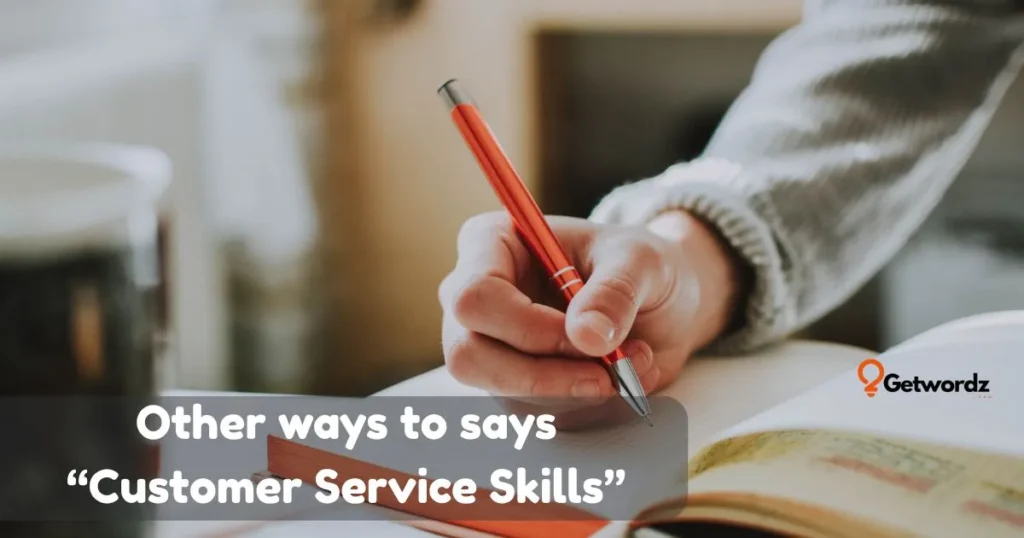“Customer Service Skills” are the art of effectively interacting with clients, resolving issues, and creating memorable experiences that keep people coming back.
Whether you’re a frontline employee, a business owner, or someone who occasionally helps friends and family navigate problems, strong customer service skills can make all the difference.
Many people search for customer service skills because they want practical ways to improve interactions, but often, advice online is repetitive or generic, focusing on clichés rather than actionable strategies.
In this post, we’re diving into creative and meaningful alternatives that go beyond the usual tips. From mastering empathy and active listening to handling complaints with finesse, you’ll discover unique expressions, better wording, and even a few fun approaches that make your communication stand out.
Whether you’re interacting with colleagues, assisting clients, or helping loved ones solve everyday problems, these techniques are designed to feel natural, authentic, and surprisingly easy to implement.
1. Active Listening in Customer Service Skills
Scenario: Imagine a customer calling about a delayed order. Instead of interrupting, you focus completely on what they are saying, noting every concern.
Explanation: Active listening is a professional, attentive approach that ensures customers feel heard and valued. It’s a better way to respond than giving generic replies, creating trust and a positive impression.
Examples:
- “I understand your concern about the delay; let’s see how we can fix it.”
- “It sounds like this issue has been frustrating. I’m here to help.”
- “Thank you for sharing the details. I’ll make sure we handle this promptly.”
Why It Works: This technique stands out because it demonstrates empathy and engagement, showing that you truly care about the customer’s experience.
2. Empathy as a Core Customer Service Skill
Scenario: A client emails frustrated about a broken product. Instead of only providing instructions, you acknowledge their feelings first.
Explanation: Empathy allows you to connect personally, showing understanding and warmth. It’s a creative alternative to robotic responses, making interactions feel human and sincere.
Examples:
- “I completely understand how disappointing this must be for you.”
- “I can see why this situation is frustrating, and I want to help.”
- “Your concerns are valid, and we’ll work to resolve this quickly.”
Why It Works: Empathy improves satisfaction and loyalty by making clients feel respected and understood, enhancing your overall customer service skills.
3. Clear and Concise Communication
Scenario: During a tech support call, you explain a solution without overloading the customer with jargon.
Explanation: Clear communication is a practical, professional approach that prevents confusion. It’s a unique expression of competence that replaces vague or overly complex explanations.
Examples:
- “You can reset your device by pressing this button for five seconds.”
- “Here’s a step-by-step guide to resolve the issue quickly.”
- “I’ll summarize the solution so it’s easy to follow.”
Why It Works: Being concise ensures the customer understands you immediately, reducing frustration and building trust in your service.
4. Positive Language Usage
Scenario: A client complains about a feature that doesn’t work as expected. You choose words that highlight solutions rather than problems.
Explanation: Positive language shifts the focus from negativity to helpfulness, making interactions constructive. It’s a creative alternative to defensive or neutral phrasing.
Examples:
- “Let’s see how we can fix this together.”
- “Good news! There’s a way to adjust this setting quickly.”
- “I’ll guide you to get the most out of this feature.”
Why It Works: Positive language creates a friendly tone, encourages collaboration, and improves the customer’s overall perception of your service.
5. Patience in Customer Interactions
Scenario: A customer struggles to understand a process over chat. You calmly repeat instructions without showing frustration.
Explanation: Patience is a professional and supportive skill that prevents stress and misunderstandings. It’s a better way to handle challenging interactions than rushing or showing irritation.
Examples:
- “No problem, let’s go through it step by step.”
- “Take your time; I’m here to help.”
- “We can revisit the instructions as many times as needed.”
Why It Works: Patience demonstrates respect and professionalism, encouraging customers to remain engaged and cooperative.
Read more: 30 Other Ways To Say “First Come First Serve” With Examples!
6. Problem-Solving Skills
Scenario: A customer receives a damaged package. You proactively offer solutions rather than just apologies.
Explanation: Problem-solving is a proactive, confident skill that shows initiative. It’s a unique expression of reliability that enhances your customer service skills.
Examples:
- “We can send a replacement immediately or offer a refund.”
- “Here’s a quick fix while we arrange a full solution.”
- “I’ve escalated this to ensure it’s resolved today.”
Why It Works: Offering clear solutions creates trust, reduces frustration, and positions you as a competent and dependable representative.
7. Personalization in Service
Scenario: A regular customer calls. You reference their previous purchases or preferences.
Explanation: Personalization adds warmth and attention to detail. It’s a creative alternative to generic responses and makes customers feel recognized.
Examples:
- “I noticed you enjoyed our last product; this might interest you too.”
- “Based on your previous order, here’s a tailored recommendation.”
- “I remember you mentioned this preference; let’s make sure it fits perfectly.”
Why It Works: Personalized service strengthens relationships, increases satisfaction, and shows genuine care.
8. Effective Feedback Handling
Scenario: A client leaves a critical review online. You respond constructively and professionally.
Explanation: Handling feedback well is essential for credibility. It’s a professional, supportive approach that transforms criticism into improvement opportunities.
Examples:
- “Thank you for your feedback; we’ll use it to improve our service.”
- “I appreciate your input and will share it with our team immediately.”
- “Your concerns are important, and we’re addressing them.”
Why It Works: Skillful feedback handling turns negative situations into positive experiences, demonstrating expertise and reliability.
9. Time Management in Customer Service
Scenario: Multiple clients are waiting for assistance, and you prioritize effectively while staying attentive.
Explanation: Time management is a practical, professional skill that ensures efficiency without sacrificing quality. It’s a better way to maintain smooth operations and customer satisfaction.
Examples:
- “I’ll assist you shortly; your patience is appreciated.”
- “Let’s schedule a convenient time to resolve this fully.”
- “I’m handling this issue efficiently to save your time.”
Why It Works: Efficient time management shows professionalism, respect for clients’ schedules, and enhances overall service quality.
10. Building Rapport with Customers
Scenario: A repeat customer seems hesitant during a purchase. You engage with light conversation to make them comfortable.
Explanation: Building rapport fosters trust and loyalty. It’s a creative alternative to strictly transactional interactions and makes customers feel valued.
Examples:
- “How has your experience been with our products so far?”
- “I’m glad to see you again! Let’s find the perfect solution.”
- “It’s always a pleasure assisting you what brings you in today?”
Why It Works: Rapport strengthens relationships, increases satisfaction, and encourages repeat business by making clients feel connected.
Read more: 30 Other Ways To Say “Happy Anniversary” With Examples!
11. Conflict Resolution Skills
Scenario: A client is upset about an incorrect billing issue. You calmly mediate and find a solution that satisfies both sides.
Explanation: Conflict resolution is a professional and empathetic approach to solving disagreements. It’s a better way to handle disputes than arguing or ignoring concerns.
Examples:
- “I understand your frustration; let’s work together to fix this.”
- “Here’s a solution that addresses both your concern and company policy.”
- “I’ll make sure this is resolved quickly to your satisfaction.”
Why It Works: Handling conflict gracefully builds trust, reduces stress, and shows competence in managing challenging situations.
12. Adaptability in Customer Service
Scenario: A client requests a service outside of your usual protocol. You adjust your approach to accommodate their needs.
Explanation: Adaptability shows flexibility and problem-solving skills. It’s a creative alternative to rigid responses, helping you meet diverse customer needs.
Examples:
- “We can customize this solution to fit your specific requirements.”
- “Let’s explore a few alternative options that might work better for you.”
- “I’m happy to adjust the process to make this easier for you.”
Why It Works: Being adaptable demonstrates responsiveness, care, and resourcefulness, which enhances customer satisfaction.
13. Professional Tone Maintenance
Scenario: A client emails angrily. You respond respectfully and professionally, maintaining calm and clarity.
Explanation: Maintaining a professional tone ensures your message is taken seriously and reduces escalation. It’s a better way to communicate than reacting emotionally.
Examples:
- “Thank you for bringing this to our attention; let’s resolve it promptly.”
- “I appreciate your patience as we work through this issue.”
- “I’m committed to finding a solution that works for you.”
Why It Works: A professional tone conveys reliability, authority, and trustworthiness, strengthening your customer service image.
14. Attention to Detail
Scenario: A client orders a customized product. You double-check every detail before finalizing the order.
Explanation: Attention to detail ensures accuracy and quality in service. It’s a creative alternative to careless or rushed approaches, demonstrating diligence.
Examples:
- “I’ve reviewed all your specifications to ensure everything is perfect.”
- “Here’s a summary of your order to confirm details before processing.”
- “We carefully checked every step to avoid any errors.”
Why It Works: Careful attention prevents mistakes, increases customer satisfaction, and shows a high level of professionalism.
15. Follow-Up Skills
Scenario: After resolving a client issue, you check back to ensure everything is satisfactory.
Explanation: Follow-up is a proactive approach to customer service. It’s a unique expression of care and commitment beyond the initial interaction.
Examples:
- “Just checking in to see if everything is working smoothly now.”
- “I wanted to make sure the solution met your expectations.”
- “Please let me know if any further assistance is needed.”
Why It Works: Following up demonstrates reliability and attention, leaving a positive, lasting impression on clients.
Read more: 30 Other Ways To Say “God Bless You” With Examples!
16. Handling Difficult Customers
Scenario: A client is rude or impatient on a call. You remain calm, listen, and resolve their issue efficiently.
Explanation: Handling difficult customers requires patience, empathy, and professionalism. It’s a better way to manage stress and turn a negative experience into a positive one.
Examples:
- “I understand this situation is frustrating; let’s find a solution together.”
- “Thank you for your feedback; I’ll work on resolving this immediately.”
- “I’m here to assist you, and I’ll make this process easier.”
Why It Works: Successfully managing challenging interactions enhances your reputation and builds customer loyalty.
17. Product Knowledge Expertise
Scenario: A client asks detailed questions about a service feature. You answer confidently and accurately.
Explanation: Strong product knowledge shows competence and authority. It’s a creative alternative to vague or unsure responses that can frustrate customers.
Examples:
- “This feature works best when you follow these steps.”
- “Here’s why this product is ideal for your needs.”
- “I can explain the benefits and limitations clearly for your understanding.”
Why It Works: Expertise builds credibility, trust, and confidence in your service skills.
18. Time-Sensitive Response Skills
Scenario: A client contacts support with an urgent issue. You respond promptly to prevent further problems.
Explanation: Responding quickly demonstrates reliability and respect for customers’ time. It’s a unique expression of efficiency and attentiveness.
Examples:
- “I’m addressing your issue immediately to ensure it’s resolved quickly.”
- “Here’s a temporary solution while we fix the problem permanently.”
- “Thank you for your patience; we’ll resolve this without delay.”
Why It Works: Timely responses prevent escalation, show professionalism, and increase customer satisfaction.
19. Multichannel Communication Skills
Scenario: A customer reaches out via email, chat, and phone. You manage all channels effectively and consistently.
Explanation: Multichannel communication ensures clients receive seamless service across platforms. It’s a better way to maintain clarity and accessibility in modern customer interactions.
Examples:
- “I’ve noted your request from email and will follow up via phone.”
- “Thank you for contacting us on chat; here’s the solution you need.”
- “We aim to provide consistent updates across all platforms.”
Why It Works: Being versatile across channels demonstrates adaptability, professionalism, and attentiveness.
20. Clear Documentation Skills
Scenario: After a client interaction, you record detailed notes for future reference and follow-ups.
Explanation: Proper documentation ensures continuity and accuracy in service. It’s a unique expression of diligence and organization.
Examples:
- “I’ve recorded all the details of our conversation for future reference.”
- “Documentation helps us avoid repeating mistakes and improve service.”
- “This note ensures any follow-up will be accurate and efficient.”
Why It Works: Clear records prevent miscommunication, improve efficiency, and demonstrate professionalism.
Read more: 30 Other Ways To Say “For The First Time” With Examples!
21. Conflict De-Escalation Techniques
Scenario: A client is escalating an issue online. You intervene calmly to defuse tension.
Explanation: Conflict de-escalation uses diplomacy and empathy to reduce stress. It’s a better way to maintain relationships and manage difficult situations.
Examples:
- “I understand your frustration; let’s work on a solution together.”
- “Let’s take a moment to clarify the situation so we can help.”
- “I’ll make sure your concerns are addressed professionally and promptly.”
Why It Works: De-escalation preserves relationships, protects brand reputation, and demonstrates emotional intelligence.
22. Building Customer Loyalty
Scenario: A client has been consistently using your service. You engage with personalized offers or greetings to strengthen the relationship.
Explanation: Loyalty-building strategies create long-term engagement. It’s a creative alternative to transactional interactions, showing clients they are valued.
Examples:
- “We appreciate your continued support and have a special offer for you.”
- “Thank you for being a loyal customer; we value your feedback.”
- “Your satisfaction is important; here’s something exclusive for you.”
Why It Works: Building loyalty ensures repeat business, positive reviews, and stronger customer relationships.
23. Adapted Tone for Different Customers
Scenario: A senior client prefers formal communication, while a younger client responds better to casual language. You adjust accordingly.
Explanation: Adapting tone demonstrates emotional intelligence and customer awareness. It’s a better way to connect authentically with diverse audiences.
Examples:
- “We appreciate your feedback and will address it promptly.” (formal)
- “Thanks for reaching out! Let’s get this sorted.” (casual)
- “I understand your concern, and we’re on it.” (neutral)
Why It Works: Matching tone to audience improves engagement, comfort, and overall satisfaction.
24. Encouraging Customer Feedback
Scenario: After a service interaction, you ask the client for constructive feedback to improve.
Explanation: Encouraging feedback shows openness and willingness to improve. It’s a creative alternative to ignoring client input or only focusing on complaints.
Examples:
- “We’d love your thoughts on how we can improve our service.”
- “Your feedback helps us serve you better in the future.”
- “Please let us know what worked well and what we can enhance.”
Why It Works: Feedback encourages engagement, trust, and continuous improvement in service quality.
25. Cultural Sensitivity in Service
Scenario: A client from a different cultural background interacts with your team. You communicate respectfully and inclusively.
Explanation: Cultural sensitivity ensures all clients feel respected and understood. It’s a better way to build rapport and prevent misunderstandings.
Examples:
- “I appreciate your perspective and will accommodate your preferences.”
- “Let’s ensure our service meets your expectations while respecting your customs.”
- “Thank you for sharing; we’ll adjust accordingly.”
Why It Works: Cultural sensitivity promotes trust, inclusivity, and stronger relationships with diverse clients.
26. Emotional Intelligence in Customer Service
Scenario: A frustrated client reaches out, and you respond with empathy and understanding.
Explanation: Emotional intelligence helps you read and respond appropriately to customer emotions. It’s a unique expression of maturity and professionalism.
Examples:
- “I understand this is frustrating; let’s solve it together.”
- “I can see why you’re upset; here’s what we’ll do.”
- “Your feelings are valid, and I’m here to assist.”
Why It Works: Emotional intelligence improves interactions, reduces conflicts, and enhances customer satisfaction.
27. Consistency in Service Delivery
Scenario: Customers expect the same quality of service every time they interact with your team.
Explanation: Consistency builds reliability and trust. It’s a better way to maintain professionalism than offering variable experiences.
Examples:
- “We ensure the same high-quality service every time you contact us.”
- “Our team follows standardized procedures for consistent results.”
- “You can expect dependable service on every interaction.”
Why It Works: Consistency reassures clients, strengthens brand credibility, and fosters loyalty.
28. Clear Escalation Process
Scenario: A client issue cannot be resolved immediately. You guide them to the next level efficiently.
Explanation: Having a clear escalation process ensures problems are addressed without delay. It’s a creative alternative to leaving customers uncertain.
Examples:
- “I’ll escalate this to our specialist team for a faster resolution.”
- “Here’s who you can contact if additional help is needed.”
- “We’re ensuring your issue is handled at the right level promptly.”
Why It Works: Clear escalation builds confidence, reduces frustration, and shows professionalism.
29. Transparency with Customers
Scenario: A product shipment is delayed, and you inform the client honestly with reasons and solutions.
Explanation: Transparency fosters trust and credibility. It’s a better way to maintain honesty rather than offering vague explanations.
Examples:
- “Due to high demand, your shipment is delayed; we apologize and are expediting it.”
- “Here’s the full update on your order status.”
- “We want to be upfront about the situation and keep you informed.”
Why It Works: Transparency reassures clients, reduces misunderstandings, and strengthens trust in your service.
30. Follow-Up for Service Improvement
Scenario: After completing a service, you contact the client to gather suggestions for improvement.
Explanation: Follow-ups for improvement show dedication and care. It’s a creative alternative to ending interactions abruptly without checking satisfaction.
Examples:
- “We’d love to hear your thoughts on how we can enhance our service.”
- “Your input will help us improve future experiences.”
- “Please share any suggestions to make our service better for you.”
Why It Works: Following up for improvement encourages engagement, demonstrates commitment, and builds long-term trust.
Pros and cons of using “Customer Service Skills”
pros
- Enhances Customer Satisfaction: Strong customer service skills ensure clients feel valued, leading to repeat business and loyalty.
- Builds Brand Reputation: Effective communication and problem-solving create a positive perception of your business.
- Boosts Professional Growth: Developing these skills improves career opportunities and personal confidence.
- Reduces Conflicts: Empathy, active listening, and patience help manage difficult interactions smoothly.
- Improves Efficiency: Clear communication, time management, and follow-up skills streamline processes and reduce misunderstandings.
Cons
- Time-Consuming: Providing personalized and attentive service can take extra time, especially for high-volume tasks.
- Emotional Drain: Dealing with frustrated or angry customers regularly can lead to stress and burnout.
- Requires Continuous Learning: Product knowledge and communication strategies need constant updates to remain effective.
- Potential for Miscommunication: Even skilled professionals can occasionally misinterpret customer needs, leading to dissatisfaction.
- Dependence on Human Factors: Customer service quality heavily relies on the mood, patience, and professionalism of the staff, which can vary.
Closing words
“Customer Service Skills” are essential for creating meaningful connections, resolving issues effectively, and leaving lasting impressions. This post offered fresh approaches, unique expressions, and creative alternatives to elevate everyday interactions, helping readers avoid repetitive or overused phrases.
Whether you’re chatting with colleagues, assisting clients, or engaging on social media, these different ways to say and demonstrate strong customer service skills provide practical, authentic options for every scenario. Try incorporating one of these techniques in your next conversation or professional note, you’ll notice how naturally it improves communication.
By using these alternatives, you can enhance authenticity, thoughtfulness, and overall impact. Embracing these customer service skills consistently makes your interactions more effective, memorable, and genuinely engaging.




